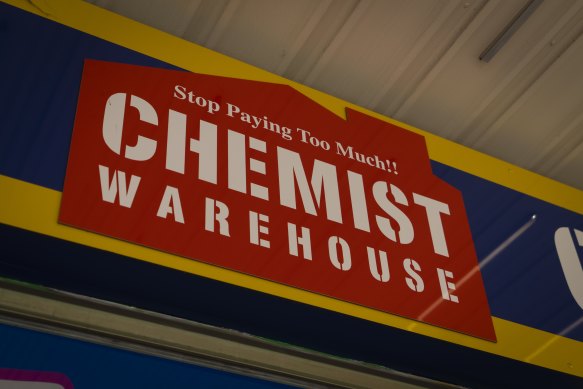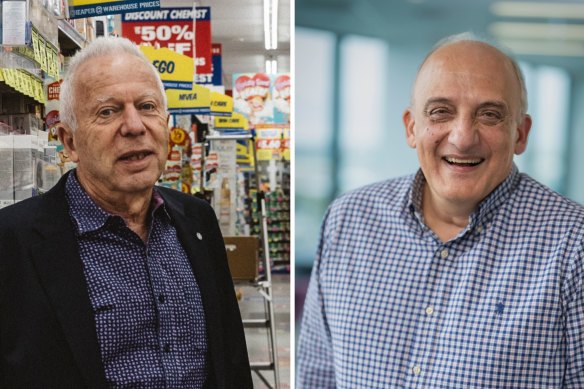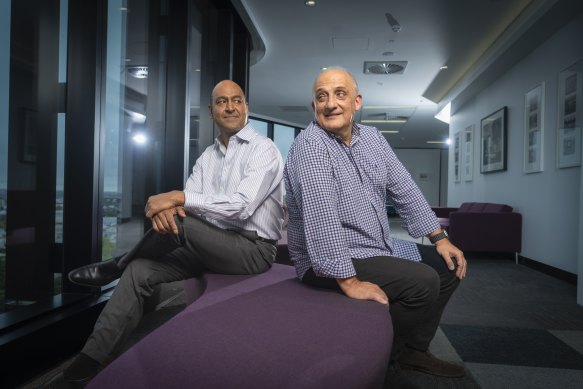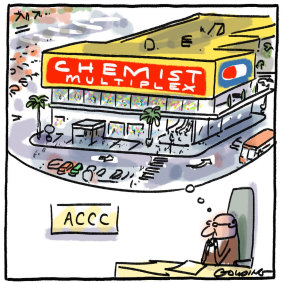This was published 9 months ago
Chemist Warehouse’s $8.8b merger could stifle competition, shut stores: ACCC
By Jessica Yun
Australia’s competition watchdog has raised concerns that Chemist Warehouse’s planned merger with Sigma Healthcare into an $8.8 billion pharmacy titan will lessen competition on the retail and wholesale levels, hinder rivals from growing or expanding, and result in the closure of chemists.
Australian Competition and Consumer Commission Commissioner Stephen Ridgeway said the deal would be a “major structural change” for the pharmacy sector and had the potential to weaken competition in medicine supply as the merged giant would also be supplying to Chemist Warehouse’s competitors.

Chemist Warehouse’s merger with Sigma is facing concerns from the competition regulator.Credit: Eamon Gallagher
This masthead revealed in December that Chemist Warehouse was planning to sell its shares on the Australian stock exchange through a reverse listing via Sigma, a pharmaceutical wholesaler and distributor, in a merger that would create an industry giant.
The ACCC is concerned pharmacies currently supplied by Sigma could be harmed by the deal, and the transaction would allow Chemist Warehouse to access commercially sensitive data about its competitors. Chemist Warehouse stores could get favourable treatment while costs are raised for rivals and terms become less favourable, the competition watchdog said.
“The merger may cause a significant and permanent structural change to the pharmacy sector, long-term effects that would be very difficult to unwind,” Ridgeway told this masthead. “That’s looming as the overarching issue.”
The competition regulator said that after the acquisition, “the merged company may be able to use insights from data obtained to target pharmacies that rival Chemist Warehouse or pre-empt and undermine them.”
This could lead to store closures of pharmacies currently supplied by Sigma, the ACCC said.
‘This lessening of competition may lead to reduced service quality for goods and services provided in pharmacies as well as higher prices for consumers.’
ACCC Commissioner Stephen Ridgeway
Ridgeway also warned that reduced competition could lead to higher prices for consumers, and impair the range and quality of services offered by independent pharmacies, such as the quality of advice from chemists and services like vaccinations, particularly in regional areas.
Around 600 Chemist Warehouse outlets in Australia are not directly owned by the head company, but the brand supplies pharmacist-owned franchise stores. Sigma supports 340 pharmacies under its Amcal and Discount Drug Stores brands.
The acquisition would combine two of the five major pharmacy chains in Australia, and “result in a material concentration of retail pharmacy stores”, said the ACCC’s statement of issues.
Sigma’s share price closed 3.7 per cent lower at the end of Thursday’s session, with the company saying the regulator’s statement of issues was “not unexpected” for a deal this complex.
“Sigma and CWG consider there are good arguments why the proposed merger will not lessen competition and will continue to engage with the ACCC to address its preliminary views and any potential concerns,” Sigma said in a statement.
Sigma chief executive Vikesh Ramsunder said his company was co-operating closely with the competition regulator.
“The proposed transaction will ensure that Sigma, consistent with its regulatory obligations, can continue to serve franchisee and independent pharmacies alike with a competitive offering, whilst delivering a transformational change for all Sigma stakeholders,” he said in a statement.
Chemist Warehouse said it was “committed to fully co-operating with the ACCC and will continue to engage in the process to ensure the commission has all the information required to complete their assessment.”

The co-founders of Chemist Warehouse, Jack Gance and Mario Verrocchi.Credit: Eamon Gallagher
The regulator is only scrutinising competition issues, and does not deal with business model or governance issues. Higher prices among the airline and supermarket industries, dominated by the Qantas-Virgin and Woolworths-Coles duopolies, have pushed merger and competition regulation into focus.
“With the nature of this sector and the potential impact on consumers, it does mean that we’re very careful and cautious about granting clearances and making decisions and reviewing applications,” Ridgeway said.
The ACCC is inviting further submissions on the matter with a deadline of 5pm on June 27. After considering submissions, the watchdog will release its final decision on the matter on September 5.
The merger could still technically go ahead without the ACCC’s blessing, but the regulator could then seek an order from the Federal Court to unwind the transaction and potentially want penalties. It would be up to Chemist Warehouse and Sigma to offer changes to the merger, such as divestment of stores, to placate the ACCC and secure approval.
Weighing in on the issue, the Pharmacy Guild of Australia said it was concerned the reverse takeover would “degrade the world-class healthcare available through Australia’s community pharmacy network” and called on state regulators to look at complex business models and pharmacy ownership laws.
“These laws expressly prohibit non-pharmacist entities, such as a publicly listed company, exerting control or influence over a pharmacy,” said a Guild spokesperson.
Chemist Warehouse notched a 28.6 per cent lift in statutory profits before tax and a 13.5 per cent jump in total network sales to $4.56 billion for the first half of the 2024 financial year. It raked in $7.9 billion in sales for the full 2023 financial year. Sigma recorded $3.4 billion in revenue last financial year.

Vikesh Ramsunder of Sigma Healthcare and Mario Verrocchi of Chemist Warehouse.Credit: Eamon Gallagher
If the merger goes ahead, Chemist Warehouse – which makes about 70 per cent of revenue from front-of-shop sales of cosmetics, skincare and health products – will generate more than two thirds of revenue of the combined entity. A typical pharmacy usually makes about 70 per cent of its revenue from prescription drugs.
Chemist Warehouse shareholders would hold 85.75 per cent of the new ASX-listed company while Sigma shareholders would own 14.25 per cent.
The two founders of Chemist Warehouse, Jack Gance and Mario Verrocchi, would join the group’s board, while chairman Michael Sammells and CEO Ramsunder would stay in their roles.
Data compiled by hedge fund research firm Wickhams Hill reveals the merged titan would have 100 per cent market share among major banner brands in areas like Darwin and 61.5 per cent in Hobart after the deal. “They basically have to unscramble the egg to get this done,” said Wickhams Hill founding partner Lloyd Moffatt. Chemist Warehouse was advised by law firm Herbert Smith Freehills, which referred to the merger as ‘Project Orbit’ in its merger implementation agreement.
Analysis by governance advisory firm Ownership Matters shows that 87 per cent of Chemist Warehouse’s revenue comes from related party transactions with entities connected to key management executives or their close families, including their children, spouses and other domestic partners.
Ownership Matters mapped 486 Australian Chemist Warehouse stores according to its business name entity name and ABN, and found 254 stores had instances of a surname related to a current or proposed director. 112 franchises are estimated to have connections with the Gance family and another 112 franchises are linked to the Verrocchi family, according to the proxy firm.
Asset manager HMC Capital founder David Di Pilla is a cousin to the Verrocchi family and his sister Danielle Di Pilla is a pharmacist, Chemist Warehouse franchisee, and the founder of Goat Soap and skincare. Both will sit on the board of the proposed joined entity.

Credit: Matt Golding
Gance and Verrocchi founded Chemist Warehouse in 2000, and said late last year their business has a 100-year growth strategy, with ambitions to become the next Walgreens or Boots.
“We have a theory, if you want to be a truly world-class iconic retail brand, it will take 100 years, so we have a three-phase plan,” Verrocchi said in a pitch to investors in December.
The Business Briefing newsletter delivers major stories, exclusive coverage and expert opinion. Sign up to get it every weekday morning.